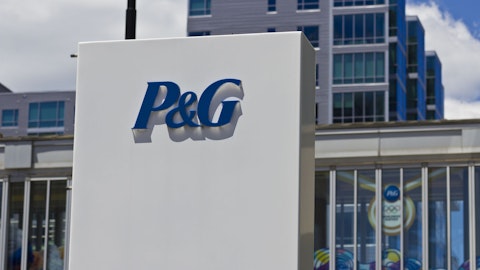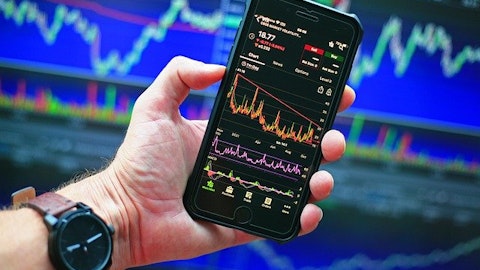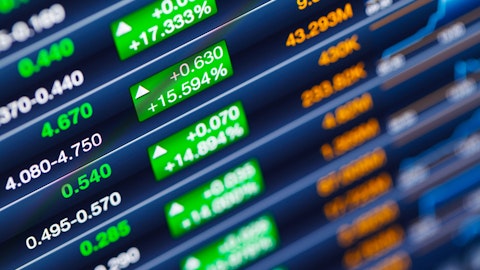In this article we are going to share 11 best low beta stocks to buy according to 900+ hedge funds tracked by Insider Monkey. You can also check out our recently published article – 12 Safest Stocks to Invest In – on a related topic.
Geopolitical tensions, concerns about inflation, and a hawkish Federal Reserve continue to make equity markets volatile. As a result, investors are bound to focus on low-beta stocks as such stocks act as a shield to current market scenario. Therefore, including some of the low-beta stocks comes as a necessity as such stocks deliver healthy returns in the long run. Inclusion of some low-beta stocks in the portfolio can make it somewhat defensive.
Stocks having a beta value of 1 means that their price activity is strongly correlated with general market. If beta value is less than 1, they tend to be less volatile in comparison to general market. On the contrary, beta value of more than 1 signifies that the stock is more volatile than general market.
As a matter of fact, low-volatility/low-beta stocks have the characteristics of a bond. Such stocks are typically large, and are profitable and dividend-paying firms. Such companies have mediocre growth opportunities. Simply put, low-beta stocks have characteristics of safety rather than components of risk and opportunity. As a result, such stocks exhibit higher correlations with long-term bond returns.
Empirical research exhibits that low-volatility securities generate higher risk-adjusted returns in the long run. That is true because such securities usually fall less in down markets. Study by Bradford Jordan and Timothy Riley in 2016 stated that high-volatility/high-beta stocks and stocks having high short interest deliver poor risk-adjusted future performance. Low-beta premium largely depends on whether low volatility is in value or growth regime, whether past returns were high or low, and general performance of size premium. Studies have shown that when low-volatility stocks continue to have value exposure, they on average, outperformed general market by approximately 2%. When low-volatility stocks have growth exposure, they tend to underperform by approximately 1.4%, on average.
Therefore, returns to low beta anomaly are justified when low-beta stocks are in value regime, and when high-beta stocks having low short interest are excluded.
PepsiCo, Inc. (NASDAQ:PEP), Exxon Mobil Corporation (NYSE:XOM), and Walmart Inc. (NYSE:WMT) are some of the best low beta stocks to buy.

Investments, Finance
Our Methodology
In order to identify the best low beta stocks to buy, we first need to identify the list of low beta stocks. For that purpose we used the holdings of ETC 6 Meridian Low Beta Equity Strategy ETF (SIXL). According to its website SIXL uses the following methodology to come up with its 200+ low beta stocks: “Stocks are first screened to remove those that score poorly on financial and growth measures. Those stocks that remain are then ranked according to their beta.” After identifying 240 low beta stocks we ranked these stocks using Insider Monkey’s proprietary hedge fund sentiment index. So our list of the 11 best low beta stocks to buy is based on more than 900 equity hedge funds’ consensus views.
11 Best Low Beta Stocks to Buy
11. Bristol-Myers Squibb Company (NYSE:BMY)
No. of Hedge Fund Holders: 68
Bristol-Myers Squibb Company (NYSE:BMY) discovers, develops, and markets drugs for a range of therapeutic areas including cardiovascular, cancer, and immune disorders. Key focus for the company is immuno-oncology, where the firm has been categorised as a leader in drug development. The company has exited several non-pharmaceutical businesses in the past to focus on branded specialty drugs.
Bristol-Myers Squibb Company’s (NYSE:BMY) Q3 results exhibit strong in-line and new product portfolio growth. The company continues to progress its product pipeline with significant regulatory and clinical milestones. It has also completed the acquisition of Turning Point Therapeutics, further expanding its precision oncology portfolio. In terms of estimates, Bristol-Myers Squibb Company (NYSE:BMY) expects total sales for FY22 of approximately $46.0 billion on US GAAP basis, while gross margin is expected to come at approximately 78%.
Analysts at Atlantic Securities initiated coverage on Bristol-Myers Squibb Company (NYSE:BMY) and increased their price target on shares of the company from $85.00 to $88.00. They gave the stock an “Overweight” rating on November 10.
Bristol-Myers Squibb Company (NYSE:BMY) was found among the 13F holdings of 68 elite hedge funds in the third quarter, with a total stake value of $1.73 billion. The company has a strong pipeline of potential treatments for over 35 diseases. Through both acquisitions and organic growth, Bristol-Myers Squibb Company (NYSE:BMY) doubled its revenues over past 5 years.
Here is what RGA Investment Advisors has to say about Bristol-Myers Squibb Company (NYSE:BMY) in their third-quarter 2022 investor letter:
“Bristol-Myers Squibb Company (NYSE:BMY), which we referenced above, boasts a double-digit free cash flow yield that gets divided roughly equally between repurchases, a dividend, and M&A in what is the best environment for acquisitions perhaps ever. In 2019, BMY acquired Celgene, who had one of the better corporate development programs in the industry. We view this as a great outlet for us as generalists considering a company like BMY should truly thrive with the ability to acquire outstanding assets and science at depressed valuations. We touched on the Turning Point acquisition above and we expect the company to be increasingly active in the M&A landscape. Importantly, Celgene also came to BMY with a phenomenal CAR-T platform. CAR-T is a cell therapy that activates the body’s immune system to target cancers. This will be a key growth vector alongside M&A in overcoming the company’s patent cliff.”
10. Charter Communications, Inc. (NASDAQ:CHTR)
No. of Hedge Fund Holders: 68
Charter Communications, Inc. (NASDAQ:CHTR) is a leading broadband connectivity company and cable operator which serves over 31 million customers in 41 states through its Spectrum brand. The company provides a full range of state-of-the-art residential and business services such as Spectrum Internet, TV, Mobile and Voice.
Charter Communications, Inc. (NASDAQ:CHTR) posted Q3 revenue of $13.6 billion which grew by 3.1% year-over-year. Mobile revenue growth of 40.2%, and advertising sales revenue growth of 22.9% were the principal growth enablers. However, residential revenue saw 0.7% growth. The company expects FY22 cable capital expenditures to be in the range of $7.1 billion – $7.3 billion.
Charter Communications, Inc. (NASDAQ:CHTR) had 27 elite hedge funds long its stock in the third quarter of 2022. Their total stake value came out to be $3.39 billion.
Pivotal Research covered Charter Communications, Inc. (NASDAQ:CHTR) on October 31, and reduced its price target on the company’s shares from $560.00 to $475.00. They have a “Buy” rating on the stock.
After getting the advantages of synergies and upgrading each network to modern broadband technologies, the company saw steady broadband growth for years. As a result, it has been able to generate healthy gains between 2016 and 2021.
Alongside PepsiCo, Inc. (NASDAQ:PEP), Exxon Mobil Corporation (NYSE:XOM), and Walmart Inc. (NYSE:WMT), Charter Communications, Inc. (NASDAQ:CHTR) is one of the 11 best low beta stocks to buy.
Weitz Investment Management, an investment management firm, published its third-quarter 2022 investor letter and mentioned Charter Communications, Inc. (NASDAQ:CHTR). Here is what the fund said:
“Liberty Broadband’s primary asset is a 26% stake in Charter Communications (NASDAQ:CHTR). Charter is not sitting still; the company is adapting via footprint expansion into underserved areas, price-advantaged mobile line growth, and so on. Charter’s hefty free cash flows are valuable in the hands of proven, astute capital allocators. Time will tell, but to paraphrase country music artist Merle Haggard, we do not yet think cable’s good times are really over for good.”
9. Walmart Inc. (NYSE:WMT)
No. of Hedge Fund Holders: 68
Walmart Inc. (NYSE:WMT) is America’s largest retailer by sales, and operates more than 10,500 stores under 46 banners in 24 countries and eCommerce websites. The company sells a variety of general merchandise and grocery items.
In Q3 2023, Walmart Inc. (NYSE:WMT) delivered strong revenue growth globally as it saw strength in Walmart U.S., Sam’s Club U.S., Flipkart, and Walmex. The company’s total revenue came in at $152.8 billion, exhibiting 8.7% growth year-over-year. Subsequent to this quarter, it approved $20 billion share repurchase authorization which replaces its existing authorization.
The company has raised its FY 2023 outlook. It expects consolidated net sales growth of approximately 5.5%. However, it expects adjusted EPS decline of 6.0% – 7.0% in Q3 2023. The decline is expected due to risk of persistent inflation, principally in general merchandise category. This is made up of discretionary items.
Research analysts at UBS Group covered Walmart Inc. (NYSE:WMT) and gave the price objective of $170.00. Elsewhere, Truist Financial raised its price target on shares of the company from $134.00 to $150.00, giving a “Hold” rating on November 16.
The company’s grocery business continues to dominate. It’s by far the largest seller of groceries in the U.S., principally when Sam’s Club is included.
At the end of Q3 2022, 68 elite hedge funds reported owning stakes in Walmart Inc. (NYSE:WMT) worth $4.08 billion. In the preceding quarter, 67 hedge funds held stakes worth $3.78 billion.
Leaven Partners, an investment management firm, released third-quarter 2022 investor letter. Here is what the fund has to say about Walmart Inc. (NYSE:WMT):
“In our last quarterly letter, I briefly mentioned that the consensus estimates for corporate profits appeared to be a bit too sanguine. I referenced a Reuters article that reported, as of June 17, Wall Street expected S&P 500 earnings to grow by 9.6% in 2022, which was up from 8.8% in April and from 8.4% in January. That tune began to change at the end of July and accelerated in August and September, as major players, such as Walmart (NYSE:WMT), has recently issued profit warnings and/or have withdrawn guidance. In response, Wall Street has altered its outlook: lowering third-quarter profit growth to 4.6%[2] from 7.2% in early August and slashing full-year profit growth to 4.5%.”
8. The Procter & Gamble Company (NYSE:PG)
No. of Hedge Fund Holders: 69
The Procter & Gamble Company (NYSE:PG) is one of the world’s largest consumer product manufacturers. It operates a line-up of over 20 leading brands that include Tide laundry detergent, Charmin toilet paper, Pantene shampoo, and Pampers diapers. It is focused on providing branded products of superior quality.
The company’s net sales came in at $20.6 billion in Q1 2023, exhibiting 1% growth against prior year, with organic sales growing by 7%. Organic sales growth stemmed from 9% percent growth from higher pricing and 1% rise from positive product mix. These increases were partially offset by 3% fall in shipment volumes.
For fiscal year 2023, The Procter & Gamble Company (NYSE:PG) maintained its outlook for organic sales growth of between 3%-5%. It expects capital spending of approximately 5% of fiscal 2023 net sales, and adjusted free cash flow productivity of 90%. The company expects to pay approximately $9 billion in dividends and to repurchase $6 billion – $8 billion of common shares in fiscal year 2023.
Jefferies Financial Group covered The Procter & Gamble Company (NYSE:PG) and they increased its price objective from $149.00 to $164.00 on November 22.
According to Insider Monkey’s data, 69 hedge funds were long The Procter & Gamble Company (NYSE:PG) at the end of Q3 2022. In the preceding quarter, 71 hedge funds held stakes in the company.
7. PepsiCo, Inc. (NASDAQ:PEP)
No. of Hedge Fund Holders: 72
PepsiCo, Inc. (NASDAQ:PEP) is a global leader in snacks and beverages, and it owns renowned household brands such as Pepsi, Mountain Dew, Gatorade, Lay’s, Cheetos, and Doritos, among others. It continues to dominate global savory snacks market and ranks as the second-largest beverage provider in the world.
PepsiCo, Inc. (NASDAQ:PEP) achieved net revenue growth of 8.8% year-over-year in the third quarter of 2022. Given the company’s YTD performance, it anticipates achieving full-year organic revenue growth of around 12% (previously 10%) and core constant currency EPS growth of around 10% (previously 8%).
Deutsche Bank Aktiengesellschaft covered PepsiCo, Inc. (NASDAQ:PEP) in their research report on September 27, and gave a “Hold” rating on the stock. On October 14, analysts at Barclays provided their take on PepsiCo, Inc. (NASDAQ:PEP) and raised its price objective from $183 to $185.
72 of the 920 hedge funds profiled by Insider Monkey during Q3 2022 reported owning the company’s shares. Their total stakes were valued at approximately $4.82 billion.
ClearBridge Investments, an investment management firm, published its Q2 2022 investor letter. It mentioned about PepsiCo, Inc. (NASDAQ:PEP). Here is what the fund said:
“Also in the stable and predictable cash flow camp, though with a very different business model, global food and beverage company PepsiCo (NYSE:PEP) reported very strong organic growth in the first quarter, driven by healthy price/mix, and raised revenue guidance, while holding EPS guidance. Notably, its beverage business showed expanding margins.”
6. Exxon Mobil Corporation (NYSE:XOM)
No. of Hedge Fund Holders: 75
Exxon Mobil Corporation (NYSE:XOM) is an integrated oil and gas company which explores, produces, and refines oil around the world.
Q3 2022 earnings came in at $19.7 billion in comparison to $17.9 billion in the preceding quarter. Higher natural gas realizations, record throughput in Energy products, and continued cost control were principal growth enablers of earnings growth. Focused cost control and growth of higher-margin petroleum and chemical products also helped earnings and cash flow growth.
Analysts at Citigroup released a research note on Exxon Mobil Corporation (NYSE:XOM) on November 22. They have raised their target price of shares of the company from $98.00 to $110.00.
By the end of third quarter of 2022, 75 of the 920 hedge funds polled by Insider Monkey held stakes worth $5.53 billion in Exxon Mobil Corporation (NYSE:XOM).
Exxon Mobil Corporation (NYSE:XOM) plans to wind down its oil production in Equatorial Guinea and intends to leave West African country once its license expires in 2026. This move exhibits wider move by major oil producers who plan to reduce crude production in West Africa. Now, they intend to shift investments to lower-carbon natural gas development on the continent.
Just like Walmart Inc. (NYSE:WMT), Merck & Co., Inc. (NYSE:MRK), and AbbVie Inc. (NYSE:ABBV), Exxon Mobil Corporation (NYSE:XOM) is one of the 11 best low beta stocks to buy.
Let us see what First Eagle Investments has to say about Exxon Mobil Corporation (NYSE:XOM) in their second-quarter 2022 investor letter. Here are the details:
“Integrated oil and gas giant Exxon Mobil performed well in the second quarter as continued high prices for energy products supported the stock. As the largest refiner in the US, the company has benefitted from wide “crack spreads,” or the margin between the cost of crude oil and the petroleum products extracted from it. Exxon continues to invest in refining capacity in the US, which industrywide has been in steady decline since 2019. We are pleased that Exxon has been using its strong cash flows to reduce debt and to return cash to shareholders through dividends and stock repurchases.”
Click to continue reading and see 5 Best Low Beta Stocks to Buy.
Suggested articles:
- 15 Biggest European Tech Companies
- Top 10 Semiconductor Manufacturing Countries in the World
- 15 Best Electric Car Stocks To Buy
Disclosure: None. 11 Best Low Beta Stocks to Buy is originally published on Insider Monkey.





